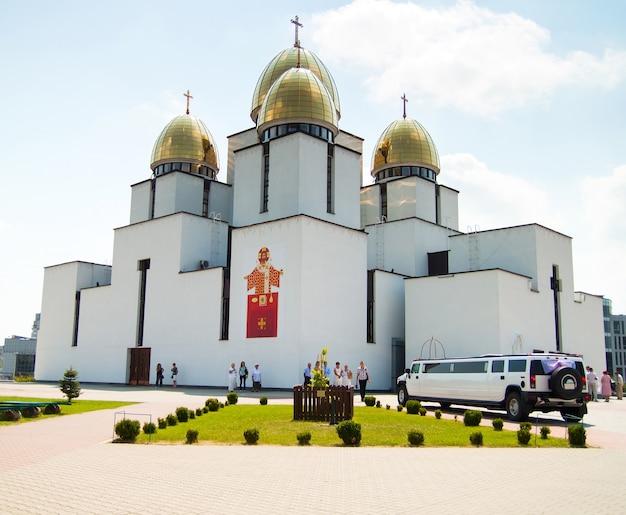Welcome to another exciting blog post! Today, we’ll explore a fascinating topic that shaped the course of history – the differences between the Eastern and Western churches in Christianity. You may have heard of the Great Schism, a major split that occurred in the church nearly a thousand years ago. If you’ve ever wondered what caused this division and how it impacted the two branches of Christianity, you’re in the right place.
The division between the Eastern and Western churches was not merely about theological disagreements, but also about cultural, political, and historical factors that played a significant role. By understanding these differences, we can gain valuable insights into the development of Christianity and the subsequent impact on the Eastern and Western worlds. So, let’s dive into this captivating topic and uncover the uniqueness of these two branches of the Christian faith.
Now that we have an idea of what’s coming, let’s begin exploring the differences and key aspects that differentiate the Eastern and Western churches. But first, let’s address an important question: What was the cause of the serious disagreement between Eastern and Western Christianity?

How were the Eastern and Western churches different?
The Eastern and Western churches had their fair share of differences, like the sun and the moon, or coffee and tea. Let’s dig into the peculiarities that set them apart:
Ecumenical Councils: Making Important Decisions!
While both the Eastern and Western churches held ecumenical councils, they often had diverse perspectives on matters of faith. The Eastern church emphasized the importance of consensus, with decisions made collectively by patriarchs and bishops. On the other hand, the Western church had a more centralized structure, with the Pope holding significant authority to make final decisions. It’s like having a rowdy family meeting versus your dad just saying, “This is how it’s gonna be!”
The Filioque Controversy: A Tongue Twister!
Ah, the filioque controversy – the source of much theological debate. In the Western church, they added the word filioque to the Nicene Creed, stating that the Holy Spirit proceeds from the Father and the Son. This didn’t sit well with the Eastern church, who believed the Holy Spirit only proceeded from the Father. It’s like arguing over whether it’s “I scream” or “ice cream.”
Language: Greek vs. Latin – The Duel of the Titans!
In the Eastern church, Greek was the primary language used in liturgy, while the Western church used Latin. It’s like listening to Despacito versus heavy metal – different vibes, same devotion. This linguistic divergence also affected theological nuances and the way religious texts were interpreted and understood.
Icons: Holy Paintings or Heresy
The Eastern church embraced icons as powerful tools for devotion, believing they provided a visual connection to the divine. However, the Western church had a more skeptical view, with some fearing that icons bordered on idolatry. It’s like arguing whether Bob Ross paintings are simply art or gateways to another realm.
Authority: All Hail the Pope!
Perhaps the most significant difference between the Eastern and Western churches was the authority of the Pope. In the Eastern church, the patriarchs held considerable power, while in the Western church, the Pope reigned supreme. It’s like having a boss who micromanages your every move versus one who lets you take charge (well, to a certain extent).
And there you have it – a glimpse into the remarkable differences between the Eastern and Western churches. From heated theological debates to language preferences and divinely inspired artwork, these distinctions shaped the religious landscape during the Byzantine and medieval eras – a testament to the fascinating intricacies of human belief and interpretation.
So, grab your preferred beverage and delve into the captivating history of these remarkable ecclesiastical establishments!

FAQ: How Were the Eastern and Western Churches Different?
In this FAQ-style section, we will explore the differences between the Eastern and Western Churches. From their religious beliefs to their cultural practices, we’ll dive into the unique aspects that set these two branches of Christianity apart. So, let’s get started!
What Sparked the Serious Disagreement between Eastern and Western Christianity
The main cause of the serious disagreement between Eastern and Western Christianity was the Great Schism of 1054. This event marked the final split between the Eastern Orthodox Church, centered in Constantinople, and the Roman Catholic Church, centered in Rome. The conflict arose due to a combination of theological, political, and cultural differences.
How did the Eastern and Western Churches Differ
Theological Differences
The Eastern and Western Churches differed in their theological beliefs, reflecting their distinct traditions and perspectives. The Eastern Orthodox Church emphasized mystical spirituality, focusing on icons and the importance of divine mystery. In contrast, the Roman Catholic Church placed greater emphasis on the role of the Pope as the ultimate authority and the Latin language in their liturgy.
Cultural Practices
Cultural differences also contributed to the divide. The Western Church had a more centralized structure, with the Pope exerting significant influence over religious matters. Conversely, the Eastern Church had a more decentralized structure, with each bishop enjoying greater autonomy. Additionally, the Eastern Church embraced Greek as its primary language, while the Western Church predominantly used Latin.
What Were the Differences between the Eastern and Western Roman Empire
The Eastern and Western Roman Empires had significant differences, which eventually influenced the development of the Eastern and Western Churches.
Geographical Split
The Roman Empire experienced a division in 395 AD, with the Western Roman Empire centered in Rome and the Eastern Roman Empire centered in Constantinople. This geographic separation brought about distinct political, social, and religious dynamics between the two regions.
Language and Culture
The Western Roman Empire primarily spoke Latin, while the Eastern Roman Empire predominantly spoke Greek. These linguistic differences shaped cultural practices and religious rituals, with the Western Church conducting their liturgy in Latin and the Eastern Church in Greek.
What Was the Greatest Contribution of the Byzantine Empire
The Byzantine Empire, which evolved from the Eastern Roman Empire, had a profound impact on the development of Eastern Christianity. One of its greatest contributions was the preservation and promotion of classical Greek culture and knowledge, keeping alive the works of ancient philosophers, writers, and scholars. This intellectual heritage profoundly influenced religious thought within the Eastern Church and shaped subsequent artistic expressions, such as Byzantine iconography and architecture.
How Did the Role of Priests Affect the Split between the Eastern and Western Churches
The role of priests played a significant role in the split between the Eastern and Western Churches.
Marital Status
In the Eastern Church, priests were allowed to marry before ordination, while the Western Church enforced clerical celibacy. This difference in marital practices contributed to a sense of contrast and divergence between the two branches of Christianity.
What Were Some Similarities between Byzantine Christianity and Roman Catholic Christianity
While there were notable differences, Byzantine Christianity and Roman Catholic Christianity shared some commonalities.
Shared Beliefs
Both Eastern and Western Christianity held many core theological beliefs in common, such as the divinity of Jesus Christ and the importance of sacraments in spiritual life. Additionally, both traditions recognized the authority of the Bible as a primary religious text.
Liturgical Practices
Both Byzantine and Roman Catholic Christianity valued liturgical rituals as an integral part of religious worship. However, they approached these practices differently due to their distinct cultural backgrounds.
Which Is the Greatest Contribution of Justinian
Justinian I, the Byzantine Emperor in the 6th century, made a lasting impact on both the Eastern Church and the wider world.
Hagia Sophia
One of his most significant contributions was the construction of the Hagia Sophia, the stunning cathedral in Constantinople. This architectural masterpiece became an enduring symbol of Byzantine Christianity, combining elements of Eastern mysticism and Roman grandeur.
Codification of Laws
Justinian’s codification of Roman laws, known as the Corpus Juris Civilis, helped to preserve and systematize legal principles inherited from ancient Rome. This legal framework provided a lasting foundation for Western legal systems.
Conclusion
By exploring the differences between the Eastern and Western Churches, we gain valuable insights into the historical and cultural factors that shaped Christian traditions. While they may have experienced disagreements and divergent paths, both branches of Christianity have left an indelible mark on the world. The Great Schism may have defined their separate identities, but it is through understanding and appreciating their distinctive qualities that we can truly honor their rich heritage.
